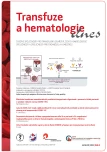Current experience with ropeginterferon Alfa-2b in Ph negative myeloproliferative neoplasm at the Department of Internal Medicine – Haematology and Oncology in Brno
Authors:
N. Podstavková 1; B. Weinbergerová 1; J. Procházková 1; M. Bohúnová 2; A. Marečková 2; J. Kotašková 2; I. Ježíšková 2; M. Doubek 1; J. Mayer 1,2
Authors‘ workplace:
Interní hematologická a onkologická klinika, LF MU a FN Brno
1; Centrum molekulární bio logie a genetiky, Interní hematologická a onkologická klinika LF MU a FN Brno
2
Published in:
Transfuze Hematol. dnes,28, 2022, No. 4, p. 213-218.
Category:
Original Papers
doi:
https://doi.org/10.48095/cctahd2022prolekare.cz15
Overview
Background: Ropeginterferon alfa-2b demonstrated efficacy and safety in patients with polycythaemia vera in the PROUD-PV and CONTINUATION-PV multicentric randomised studies. These studies reported the superior effect of ropeginterferon alfa-2b in attaining haematological and molecular remission during the fourth and fifth year of therapy. Patients and Methods: A total of 14 Ph-MPN patients treated with ropeginterferon alfa-2b at our Dept. of Internal Medicine – Haematology and Oncology were analysed from May 2020 to July 2022. Therapy duration, dosing, effect, and tolerance were evaluated. Results: Therapy median duration was 266 days. 14 patients in total were treated; 11 had polycythaemia vera (79%), 2 had essential thrombocythemia (14%), and one patient had secondary myelofibrosis post polycythaemia vera (7%). The median ropeginterferon alfa 2-b dose was 150 μg. Complete haematological remission was attained in 11 (79%) patients. Two patients (14%) had to discontinue treatment. During therapy, six patients (43%) suffered adverse events; only one patient (7%) developed a thromboembolic event. Conclusion: Our initial experience has confirmed the promising effect of ropeginterferon alfa 2-b on haematocrit control and its excellent tolerance among patients.
Keywords:
polycythemia vera – Ph negative myeloproliferative neoplasms – ropeginteferon alpha-2b
Sources
1. Dunbar AJ, Rampal RK, Levine R. Leukemia secondary to myeloproliferative neoplasms. Blood. 2020; 136 (1): 61–70.
2. Spivak JL. Polycythemia vera. Curr Treat Options Oncol. 2018; 19 (2): 12.
3. Hasselbalch HC, Holmstrom MO. Perspectives on interferon-alpha in the treatment of polycythemia vera and related myeloproliferative neoplasms: minimal residual disease and cure? Semin Immunopathol. 2019; 41: 5–19.
4. Griesshammer M, Gisslinger H, Mesa R. Current and future treatment options for polycythemia vera. Ann Hematol. 2015; 94: 901–910.
5. Gisslinger H, Zagrijtschuk O, Buxhofer-Ausch V, et al. Ropeginterferon alfa-2b, a novel IFNa-2b, induces high response rates with low toxicity in patients with polycythemia vera. Blood. 2015; 126 (15): 1762–1769.
6. Hasselbalch HC. A new era for IFN-a in the treatment of Philadelphia-negative chronic myeloproliferative neoplasms. Expert Rev Hematol. 2011; 4 (6): 637–655.
7. Kiladjian JJ, Cassinat B, Turlure P, et al. High molecular response rate of polycythemia vera patients treated with pegylated interferon alpha-2a. Blood. 2006; 108 (6): 2037–2040.
8. Marchetti M, Vannucchi AM, Griesshammer M, et al. Appropriate management of polycythaemia vera with cytoreductive drug therapy: European LeukemiaNet 2021 recommendations. Lancet Haematol. 2022; 9 (4): e301–e311.
9. Gisslinger H, Klade C, Georgiev P, et al. PROUD-PV Study Group. Ropeginterferon alfa-2b versus standard therapy for polycythaemia vera (PROUD-PV and CONTINUATION-PV): a randomised, non-inferiority, phase 3 trial and its extension study. Lancet Haematol. 2020; 7 (3): e196–e208.
10. Alvarez-Larrán A, Bellosillo B, Pereira A, et al. JAK2V617F monitoring in polycythemia vera and essential thrombocythemia: clinical usefulness for predicting myelofibrotic transformation and thrombotic events. Am J Hematol. 2014; 89: 517–523.
11. Verstovsek S, Komatsu N, Gill H, et al. SURPASS-ET: phase III study of ropeginterferon alfa-2b versus anagrelide as second-line therapy in essential thrombocythemia. Future Oncol. 2022; 18 (27): 2999–3009.
12. https: //ctep.cancer.gov/protocoldevelopment/electronic_applications/docs/ctcae_v5_quick_reference_8.5x11.pdf
13. Barosi G, Mesa R, Finazzi G, et al. Revised response criteria for polycythemia vera and essential thrombocythemia: an ELN and IWG-MRT consensus project. Blood. 2013; 121 (23): 4778–4781.
14. Barbui T, Barosi G, Birgegard G, et al. European LeukemiaNet. Philadelphia-negative classical myeloproliferative neoplasms: critical concepts and management recommendations from European LeukemiaNet. J Clin Oncol. 2011; 29 (6): 761–770.
15. Barbui T, Finazzi G, Carobbio A, et al. Development and validation of an International Prognostic Score of thrombosis in World Health Organization-essential thrombocythemia (IPSET-thrombosis). Blood. 2012; 120 (26): 5128–5133. AE verze 5.0. z roku 2017
Labels
Haematology Internal medicine Clinical oncologyArticle was published in
Transfusion and Haematology Today

2022 Issue 4
Most read in this issue
- Haemolytic disease of the foetus and new-born
- Beta-thalassemia minor and maior in pregnancy
- Current experience with ropeginterferon Alfa-2b in Ph negative myeloproliferative neoplasm at the Department of Internal Medicine – Haematology and Oncology in Brno
- How do anti-SARS-CoV-2 IgG and IgM predict the titre of virus-neutralizing antibodies in donors of convalescent plasma against COVID-19 disease?
